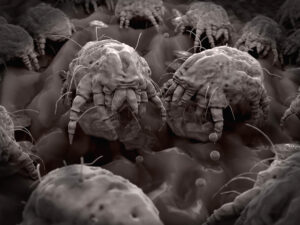December 01, 2021 | Black & Kletz Allergy

Dust mites live off of sloughed skin or dander of both humans and animals. When you sleep at night, you shed dead skin and these skin flakes are the food that sustains dust mites. The average person sheds 0.2 to 0.3 ounces of dead skin each week which becomes the fuel that keeps the dust mites alive. As mentioned above, the “dust” one sees from the rays of light near a window in a room is not allergenic because in general, dust mites do not live in free-floating air. It is interesting to note that the “dust” one sees near a well-lit window is mostly made up of dead skin from humans and/or animals.
There are 2 species of dust mites found in the U.S. Their names of these 2 species are Dermatophagoides farina (i.e., North American house dust mite) and Dermatophagoides pteronyssinus (i.e., European house dust mite). As stated previously, dust mites are the main “dust” allergen. It is however a protein in the dust mite feces and a protein in the exoskeleton (i.e., external skeleton) of the dust mites that are the true allergens. Dust mites have 8 legs and are arthropods belonging to the class Arachnida. In that way, they are similar to spiders. Dust mites are between 0.2 to 0.3 mm. in length and are translucent, making them almost invisible to the naked eye.
Dust mites cause allergic rhinitis (i.e., hay fever), allergic conjunctivitis (i.e., eye allergies), and asthma symptoms in sensitized individuals. The classic symptoms of allergic rhinitis may include sneezing, runny nose, nasal congestion, post-nasal drip, sinus congestion, sinus headaches, itchy throat, fatigue, and/or snoring. In addition, individuals with allergic rhinitis are more prone to developing sinus infections. Allergic conjunctivitis symptoms may include itchy eyes, watery eyes, redness of the eyes, and/or puffiness of the eyes. The typical asthma symptoms that one may experience are wheezing, chest tightness, coughing, and/or shortness of breath. Asthma can range in severity from mild intermittent to severe persistent. In some instances, it can be life-threatening. It is thus crucial for individuals with asthma to adhere to a strict plan of action that can be tailored to them by a board certified allergist, like the ones at Black & Kletz Allergy.
The diagnosis of dust mite allergy begins when the allergist takes a comprehensive history from the patient and then follows that up by a complete physical examination. Allergy testing is usually performed using the more common allergy skin tests, however, blood tests can be done in select individuals. Pulmonary function tests are usually performed when asthma symptoms are present. Occasionally a chest X-ray may be indicated.
The treatment of dust mite allergy begins with prophylaxis. Preventing as much exposure to dust mites is highly recommended, although not always attainable. Covering pillows, mattresses, box springs with allergy-proof encasings are a great place to start. Using HEPA filters and changing the filters frequently are also helpful in reducing one’s dust mite exposure.
Treatment usually continues with medications. There are numerous medications that can be utilized in the treatment of allergic rhinitis, allergic conjunctivitis, and asthma. Oral antihistamines, oral decongestants, oral leukotriene antagonists, nasal corticosteroids, nasal antihistamines, nasal anticholinergics, ocular antihistamines, ocular decongestants, ocular mast cell stabilizers, inhaled corticosteroids, and inhaled bronchodilators are the most commonly used medications to treat allergic rhinitis, allergic conjunctivitis, and asthma. Rarely, oral corticosteroids may be used in severe cases of allergies and asthma. It should be noted that allergy shots (i.e., allergy injections, allergy immunotherapy, allergy desensitization, allergy hyposensitization) are very helpful in the treatment of dust mite allergies as well as with the treatment of allergies to molds, pollens, pets, cockroach, and insect stings (e.g., bees, wasps, hornets, yellow jackets, fire ants). Allergy shots are effective in 80-85% of the people who take them. They have been used in the U.S. for more than 100 years and they are usually taken for 3-5 years.
The board certified allergy doctors at Black & Kletz Allergy are always available for our patients to ask any questions that they may have regarding asthma or allergies. We have been diagnosing and treating adult and pediatric patients with dust mite allergies as well as other allergies, including allergic rhinitis, allergic conjunctivitis, asthma, and insect sting allergies for more than 50 years. We have 3 office locations in the Washington, DC, Northern Virginia, and Maryland metropolitan area with offices in Washington, DC, McLean, VA (Tysons Corner, VA), and Manassas, VA. All of our offices offer on-site parking and the Washington, DC and McLean, VA offices are Metro accessible. There is a free shuttle that runs between our McLean, VA office and the Spring Hill metro station on the silver line. If you would like to be evaluated today for dust mite allergies or any other type of allergies, please call us today. You may also click Request an Appointment instead and we will respond to your request within 24 hours by the next business day. The allergy doctors at Black & Kletz Allergy pride themselves in providing the highest quality asthma and allergy care in the Washington, DC metropolitan area.












